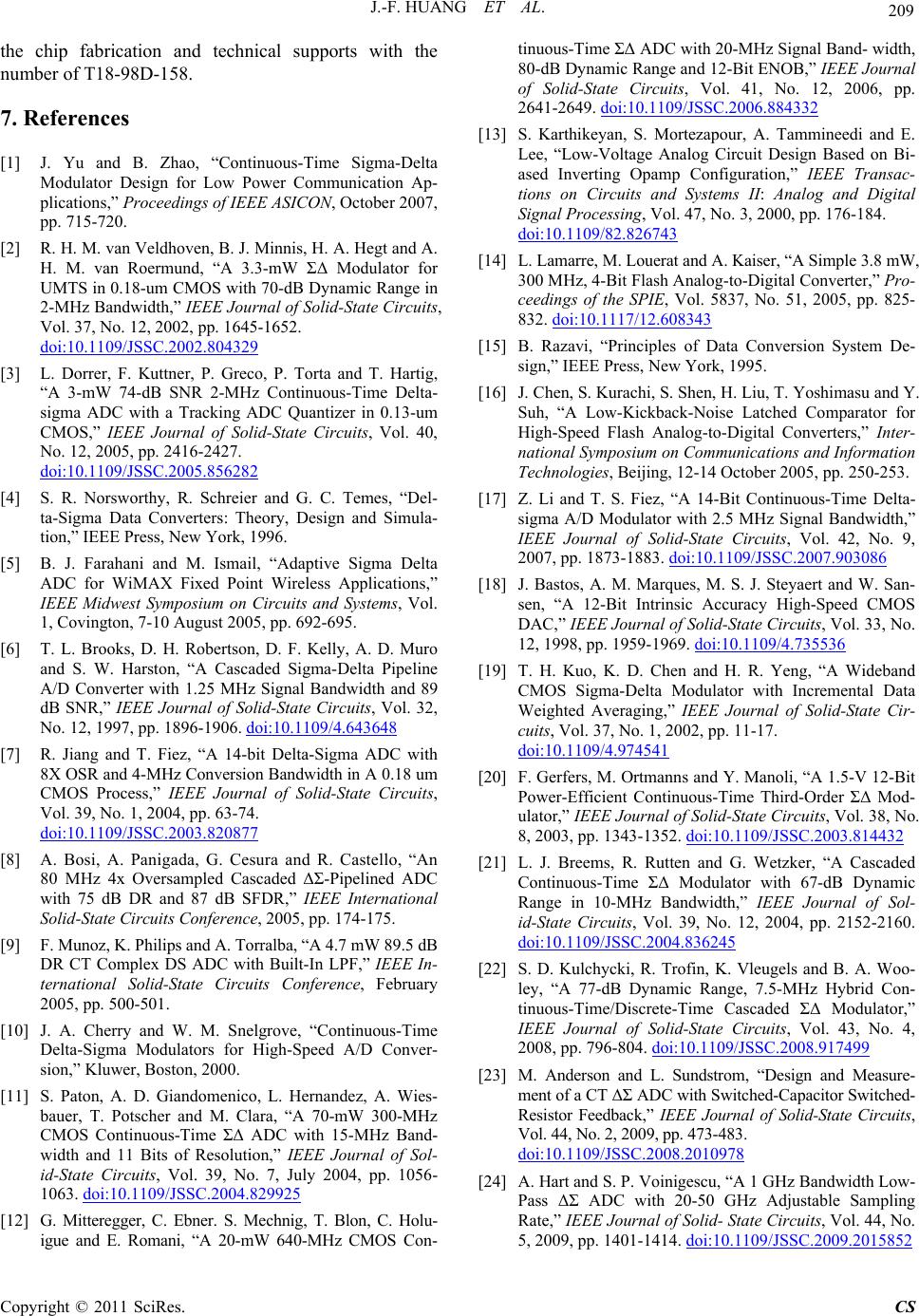
J.-F. HUANG ET AL.
209
e chip fabrication and technical supports with
. Zhao, “Continuous-Time Sigma-Delta
Modulator Design for Low Power Communication
oermund, “A 3.3-mW ΣΔ Modulator for
th the
number of T18-98D-158.
7. References
[1] J. Yu and B
Ap-
plications,” Proceedings of IEEE ASICON, October 2007,
pp. 715-720.
[2] R. H. M. van Veldhoven, B. J. Minnis, H. A. Hegt and A.
H. M. van R
UMTS in 0.18-um CMOS with 70-dB Dynamic Range in
2-MHz Bandwidth,” IEEE Journal of Solid-State Circuits,
Vol. 37, No. 12, 2002, pp. 1645-1652.
doi:10.1109/JSSC.2002.804329
[3] L. Dorrer, F. Kuttner, P. Greco, P. Tor
“A 3-mW 74-dB SNR 2-MHz
ta and T. Hartig
Continuous-Time D
,
elta-
sigma ADC with a Tracking ADC Quantizer in 0.13-um
CMOS,” IEEE Journal of Solid-State Circuits, Vol. 40,
No. 12, 2005, pp. 2416-2427.
doi:10.1109/JSSC.2005.856282
[4] S. R. Norsworthy, R. Schreier
ta-Sigma Data Converters: Theo
and G. C. Temes, “Del-
ry, Design and Simula-
eless Applications,”
a Pipeline
tion,” IEEE Press, New York, 1996.
[5] B. J. Farahani and M. Ismail, “Adaptive Sigma Delta
ADC for WiMAX Fixed Point Wir
IEEE Midwest Symposium on Circuits and Systems, Vol.
1, Covington, 7-10 August 2005, pp. 692-695.
[6] T. L. Brooks, D. H. Robertson, D. F. Kelly, A. D. Muro
and S. W. Harston, “A Cascaded Sigma-Delt
A/D Converter with 1.25 MHz Signal Bandwidth and 89
dB SNR,” IEEE Journal of Solid-State Circuits, Vol. 32,
No. 12, 1997, pp. 1896-1906. doi:10.1109/4.643648
[7] R. Jiang and T. Fiez, “A 14-bit Delta-Sigma ADC with
8X OSR and 4-MHz Conversion Bandwidth in A 0.18 um
CMOS Process,” IEEE Journal of Solid-State Circuits,
Vol. 39, No. 1, 2004, pp. 63-74.
doi:10.1109/JSSC.2003.820877
[8] A. Bosi, A. Panigada, G. Cesura
80 MHz 4x Oversampled Cascaded
and R. Castello, “An
ΔΣ-Pipelined ADC
In-
ators for High-Speed A/D Conver-
ara, “A 70-mW 300
with 75 dB DR and 87 dB SFDR,” IEEE International
Solid-State Circuits Conference, 2005, pp. 174-175.
[9] F. Munoz, K. Philips and A. Torralba, “A 4.7 mW 89.5 dB
DR CT Complex DS ADC with Built-In LPF,” IEEE
ternational Solid-State Circuits Conference, February
2005, pp. 500-501.
[10] J. A. Cherry and W. M. Snelgrove, “Continuous-Time
Delta-Sigma Modul
sion,” Kluwer, Boston, 2000.
[11] S. Paton, A. D. Giandomenico, L. Hernandez, A. Wies-
bauer, T. Potscher and M. Cl-MHz
CMOS Continuous-Time ΣΔ ADC with 15-MHz Band-
width and 11 Bits of Resolution,” IEEE Journal of Sol-
id-State Circuits, Vol. 39, No. 7, July 2004, pp. 1056-
1063. doi:10.1109/JSSC.2004.829925
[12] G. Mitteregger, C. Ebner. S. Mechnig, T. Blon, C. Holu-
igue and E. Romani, “A 20-mW 640-MHz C
tinuous-Time ΣΔ ADC with 20-MHz Signal Band- width,
80-dB Dynamic Range and 12-Bit ENOB,” IEEE Journal
of Solid-State Circuits, Vol. 41, No. 12, 2006, pp.
2641-2649. doi:10.1109/JSSC.2006.884332
[13] S. Karthikeyan, S. Mortezapour, A. Tammineedi and E.
Lee, “Low-Voltage Analog Circuit Design Based on Bi-
ased Inverting Opamp Configuration,” IEEE Transac-
tions on Circuits and Systems II: Analog and Digital
Signal Processing, Vol. 47, No. 3, 2000, pp. 176-184.
doi:10.1109/82.826743
[14] L. Lamarre, M. Louerat and A. Kaiser, “A Simple 3.8 mW
300 MHz, 4-Bit Flash A
,
nalog-to-Digital Converter,” Pro-
ceedings of the SPIE, Vol. 5837, No. 51, 2005, pp. 825-
832. doi:10.1117/12.608343
[15] B. Razavi, “Principles of Data Conversion System De-
sign,” IEEE Press, New York, 1995.
ed Comparator for
[16] J. Chen, S. Kurachi, S. Shen, H. Liu, T. Yoshimasu and Y.
Suh, “A Low-Kickback-Noise Latch
High-Speed Flash Analog-to-Digital Converters,” Inter-
national Symposium on Communications and Information
Technologies, Beijing, 12-14 October 2005, pp. 250-253.
[17] Z. Li and T. S. Fiez, “A 14-Bit Continuous-Time Delta-
sigma A/D Modulator with 2.5 MHz Signal Bandwidth,”
IEEE Journal of Solid-State Circuits, Vol. 42, No. 9,
2007, pp. 1873-1883. doi:10.1109/JSSC.2007.903086
[18] J. Bastos, A. M. Marques, M. S. J. Steyaert and W. San-
sen, “A 12-Bit Intrinsic Accuracy High-Speed CMOS
DAC,” IEEE Journal of Solid-State Circuits, Vol. 33, No.
12, 1998, pp. 1959-1969. doi:10.1109/4.735536
[19] T. H. Kuo, K. D. Chen and H. R. Yeng, “A Wideband
CMOS Sigma-Delta Modulator with Incremental Data
Weighted Averaging,” IEEE Journal of Solid-State Cir-
cuits, Vol. 37, No. 1, 2002, pp. 11-17.
doi:10.1109/4.974541
[20] F. Gerfers, M. Ortmanns and Y. Manoli
Power-Efficient Contin
, “A 1.5-V 12-Bit
uous-Time Third-Order ΣΔ Mod-
ulator,” IEEE Journal of Solid-State Circuits, Vol. 38, No.
8, 2003, pp. 1343-1352. doi:10.1109/JSSC.2003.814432
[21] L. J. Breems, R. Rutten and G. Wetzker, “A Cascaded
Continuous-Time ΣΔ Modulator with 67-dB Dynamic
Range in 10-MHz Bandwidth,” IEEE Journal of Sol-
id-State Circuits, Vol. 39, No. 12, 2004, pp. 2152-2160.
doi:10.1109/JSSC.2004.836245
[22] S. D. Kulchycki, R. Trofin, K. Vleugels and B. A. Woo-
ley, “A 77-dB Dynamic Range, 7.5-MHz Hybrid Con-
tinuous-Time/Discrete-Time Cascaded ΣΔ Modulator,”
IEEE Journal of Solid-State Circuits, Vol. 43, No. 4,
2008, pp. 796-804. doi:10.1109/JSSC.2008.917499
[23] M. Anderson and L. Sundstrom, “Design and Measure-
ment of a CT ΔΣ ADC with Switched-Capacitor Switched-
Resistor Feedback,” IEEE Journal of Solid-State Circuits,
Vol. 44, No. 2, 2009, pp. 473-483.
doi:10.1109/JSSC.2008.2010978
[24] A. Hart and S. P. Voinigescu, “A 1 GHz Bandwidth Low-
Pass ΔΣ ADC with 20-50 GHz
Adjustable Sampling
Rate,” IEEE Journal of Solid- State Circuits, Vol. 44, No.
5, 2009, pp. 1401-1414. doi:10.1109/JSSC.2009.2015852
MOS Con-
Copyright © 2011 SciRes. CS